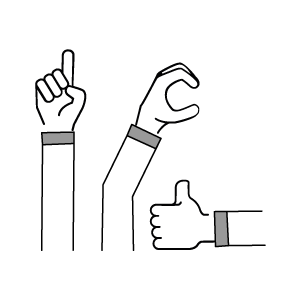Finger Rules

This effective technique can be used at any meeting to make discussions more structured and efficient. By using simple hand gestures, participants can express different opinions and desires.
Goal
Establish simple rules and hand signs for more structured and efficient discussions.
Materials
Instructions
Preparation
Prepare a flipchart with drawings of all the hand signs that you want to use during the meeting and a short description of each. Here are the most common ones.
Signs for requesting to speak/comment:
- (1-finger): the participant wants to raise a new topic that is not a direct reply to the current discussion.
- (2-fingers): the participant has a direct reply to the current topic/speaker.
- (Pinky/little finger): there is a technical remark such as a factual mistake (e.g. we are looking at the wrong document) or other technical issues preventing the participants from properly following the meeting (e.g. participant cannot hear the person speaking).
- (C-shape): the participant wants to request clarification on the topic or what the current speaker is saying.
- (Cutting fingers): participants who had previously requested to speak but haven’t yet, can use this sign to signal to the facilitator that they are rescinding, or “cutting”, their request to speak.
Signs for expressing opinion:
- (3-fingers): the participant feels the discussion is off topic
- (Thumbs up/horizontal/down): participants express support for, a neutral position or disagreement with an idea, argument, or proposal.
Flow
- Introduce the finger rules by showing the prepared flipchart. Explain each sign briefly and that a direct reply (2-fingers) has higher priority over a new topic (1-finger). Additionally, technical remarks (pinky) and clarification requests (c-shape) are given highest priority.
- Tell participants you will keep track mentally, or on paper for bigger groups, of who is raising their hand. Explain that they should keep their hand up (for signs requesting to speak) until you have given them acknowledgment (nod) that you’ve registered their hand. Signs for expressing opinion should be kept up until the comment is no longer relevant (e.g. voting is over, topic has changed).
- Start the discussion with the first person who raises a topic (1-finger)
- Take any direct reply (2-fingers) until
- there are no more 2-fingers
- you run out of planned time for this topic
- several people have expressed that the discussion is off topic (3-fingers)
- there is a technical remark (small finger) or request for clarification (C-shape) (Take these first before you continue.)
- Continue with the next topic (1-finger) or, if the discussion is over, with the next item on the agenda.
Facilitation tips
- For bigger meetings, it’s good to keep a list of who is requesting to speak so you can call on them in the correct order.
- When people use the “cut” sign, you can put a question mark next to their name; when their turn comes, double-check that they still want to cut their remark.
- If the room and meeting format allow for it, you can keep the speaking list visible for everybody (e.g. on a flipchart).
- In the beginning, people will confuse and/or abuse the rules (e.g. raising a 2-finger “direct reply” when they really have a new topic). When that happens, politely remind them of the rules, and if needed, cut them and put them back on the correct list. With practice, the rules will become second nature, and people will not need reminders.
Attachments
- finger-rules-cover.png
- finger-rules-explanation.png
Background
I first came about this method many years ago in BEST, a youth NGO, where it was very effectively used everywhere from smaller management meetings to 300 people general assemblies.
More recently similar methods have been used in agile software development teams by UK's Government Digital Service drawing upon a method from peaceful protest movements.
Author
I co-founded SessionLab - a platform for workshop planning and process design - based on my experience as facilitator that wanted better digital tools to create and share knowledge about innovation and creative processes.
More about author